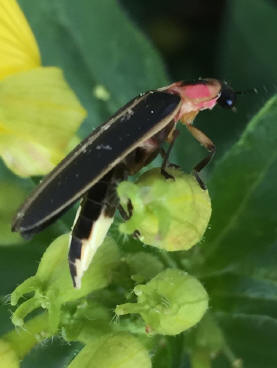 "The General Assembly of the Commonwealth of Pennsylvania hereby enacts as follows: Section 1. The firefly (Lampyridae) is hereby selected, designated and adopted as the official insect of the Commonwealth of Pennsylvania."
"The General Assembly of the Commonwealth of Pennsylvania hereby enacts as follows: Section 1. The firefly (Lampyridae) is hereby selected, designated and adopted as the official insect of the Commonwealth of Pennsylvania."
Thus reads House Bill 1708, 1973-1974, signed by Governor Milton Shapp in April 1974. It was sponsored by Frank Lynch of Delaware County, after Upper Darby Elementary School students campaigned for this legislation. When they learned that a species of lightning bug was named after Pennsylvania, which at the time lacked an official insect, they began letter-writing and petition drives. Finally, with the stroke of his pen, the Governor made the firefly (Photuris pennsylvanica), the official state insect.
The bill uses the word firefly; however, the term lightning bug also refers to these same beetles. Although the two names are interchangeable, lightning bug is primarily used in the southern and mid-western United States. Conversely, residents of the northeast and west say firefly. www.grammarist.com/usage/firefly-and-lightning-bug/
To explain this differentiation, "Business Insider" presents the theory that this geographical division of the names reflects nature. It concludes that the sections of the country where the most lightning strikes occur use the name lightning bug, while areas that have the most wildfires use firefly.
No matter what the name, their light show is a sure sign of summer. Their glow is caused by a process called bioluminescence. It does not create any heat or emit infrared or ultraviolet wavelengths. Specifically, two chemicals exist inside these insects: luciferin and luciferase, which react when oxygen and some other compounds are present. Luciferin is the compound that generates light, and luciferase is the enzyme that drives the emission of light. This activity occurs in the light cells of the last two or three abdominal segments. By controlling the diversion of oxygen to this area, the beetles control bioluminescence, which is used for communication to scare predators and find mates.
On the most basic level, the flash warns predators that, if eaten, fireflies will taste terrible, according to a study in "Science Advances," dated August 22, 2018. More frequently, communication occurs between males and females to find a mate.
Most male lightning bugs fly, while females do not. Instead, they perch on tall grass and shrubs. As the males fly by, they blink in specific patterns to their species, which can differ in brightness, color, duration, or hue. If a female is interested, she will flash in reply, indicating her location.
However, the females of the genus Photuris (which eats as an adult, unlike other genera) imitate the blinking patterns of females of other species to attract males of those different species. When the males land, the females grab them with their sharp claws and consumes them. By doing so, they ingest lucibufagins, the toxic chemicals in their bodies which are passed to her eggs, thereby giving them a chemical defense. Also, one study concluded that females with a higher level of this toxin become less appetizing to spiders that attacked and bit them. Not surprising then that females of the genus Photuris have earned the nickname femme fatales.
In the early summer in Pennsylvania, trees and fields can fill with the uncoordinated flashes of fireflies. In other areas of the world, these beetles blink simultaneously in order to find a mate. In Southeast Asia, the genus Pteroptyx resides in forested areas along riverbanks and mate throughout the year. They gather in trees in large groups and flash in union. Other species synchronize their flashes over a few-second period, appearing as waves of alternating light and dark. They reside on the East Coast from Pennsylvania to Georgia. One of the most famous is the "light show" of the Photinus carolinus at Elkmont in Great Smoky Mountains National Park, which is the only species in America to demonstrate such timing. Mating season lasts two weeks; the peak occurs sometime between the third week in May and the third week in June. The reason for this behavior is unknown. Males may be competing with each other to be the first to flash or, if they flash at the
same time, they may increase their chances of being noticed and perceived as favorable mates by the females.
Like gardening for birds or pollinators, a garden can be used to attract fireflies. According to the The Old Farmer’s Almanac, the following steps can help:
Fireflies need shrubs and low trees for daytime shelter, so plant native vegetation in the yard.
Fireflies also like grassy meadows or large patches of grass, so plant tall native grasses and/or flowers or allow parts of the lawn away from animal and human traffic to grow tall. The female lightning bugs perch on the tips of long blades of grass to search for mates.
Fireflies prefer moisture. Allow leaf litter to accumulate; the dampness of the leaves will attract snails, the favorite food of their larvae.
As water sources for them, set up bird baths near the areas described above.
Finally, do not use chemicals that repel mosquitos because they also repel fireflies. www.almanac.com/content/fireflies-why-do-fireflies-glow
These actions and others will keep the Pennsylvania state bug glowing for years to come.
Read other articles on birds, wildlife & beneficial insects